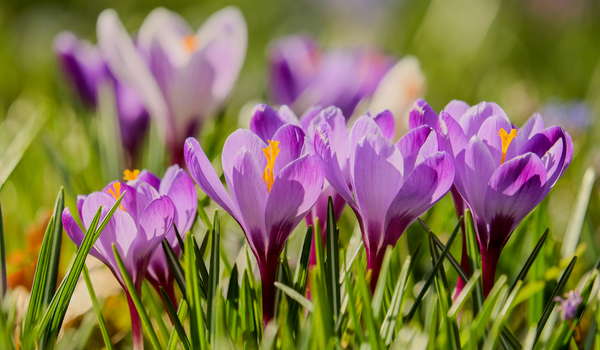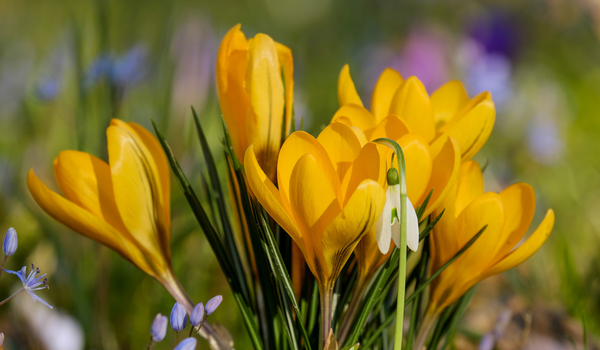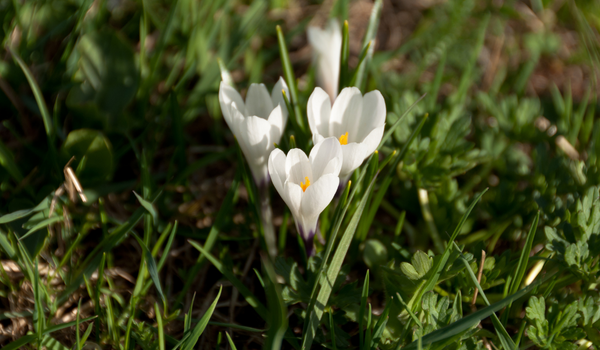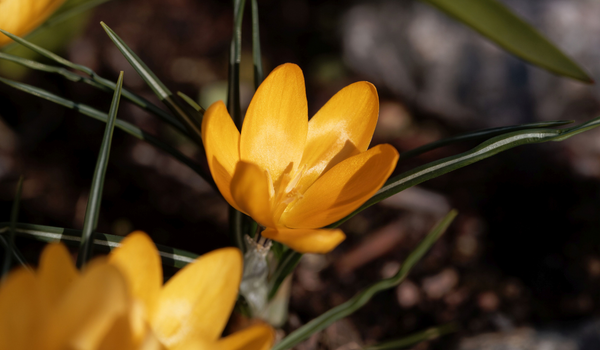How to care for Crocuses? - The ultimate caring guide for Crocuses
Welcome to our comprehensive guide on caring for Crocuses, the flower that’s giving a sign of Spring. Known for their delicate beauty, Crocuses are relatively easy to grow but thrive best with a bit of tender love, and care. In this ultimate caring guide, we'll delve into the essential tips for nurturing these charming flowers, covering everything from soil preparation to watering, sunlight, and pest management. Whether you're a seasoned gardener or just starting, our guide aims to equip you with the knowledge needed to cultivate a stunning display of Crocuses that will enchant your garden.
To get started with planting these beautiful flowers, you can find a variety of crocus bulbs here.
Enhancing Crocus blooms: tips for bigger flowers
To maximize the size and beauty of your Crocus blooms, a few key tips can make a significant difference. Firstly, ensure they are planted in well-draining soil enriched with organic matter like compost or peat moss. Adequate sunlight exposure is crucial for robust growth, so choose a location with plenty of sunlight. When planting, space the bulbs properly to allow each flower ample room to develop. Regular watering during their growing period is essential but avoid waterlogging the soil. Finally, consider applying a balanced fertilizer low in nitrogen during the growing season to encourage larger, more vibrant Crocus blooms that will adorn your garden with their exquisite beauty.
To learn more about how to grow crocus, check out our detailed guide how to grow crocus. Want to know to plant crocuses? We’ve got you covered! We’ve got a great guide for this.

Watering strategies for healthy Crocus growth
Proper watering is crucial for vibrant Crocus blooms. These resilient bulbs thrive with consistent moisture during their active growth phase. Initially, after planting, ensure a thorough watering to settle the soil. Throughout their growth period, maintain slightly moist soil, allowing it to dry out between watering sessions to prevent waterlogging. Utilize a slow and deep watering method to encourage strong root development. In hot climates, adjust the watering frequency to prevent parched soil. Avoid overhead watering to prevent fungal diseases. Applying a layer of mulch helps retain moisture and regulates soil temperature.
Pinching Crocus: determining the optimal height
Pinching crocuses, though not necessary, can help control their height for optimal display. To determine the ideal height, consider the variety—typically, crocuses range from 3 to 6 inches tall. Pinching involves removing the central bud or the topmost growth to encourage lateral budding and sturdier stems. This technique can influence height, preventing crocuses from becoming leggy or overly tall, ensuring a more compact and vibrant display. It's best to pinch shortly after planting or when the sprouts reach around 2 inches in height. Experiment with pinching techniques on a few bulbs to gauge the desired height for your crocuses.
Is staking necessary with crocuses?
Staking is generally unnecessary for crocuses due to their small, delicate structure. These resilient flowers rarely require support as they emerge from the soil. However, in areas with heavy winds or if planting in groups, staking can prevent possible damage and help maintain the aesthetic appeal of the display. Opt for inconspicuous stakes or utilize natural elements like twigs to gently support the blooms without overshadowing their beauty. Additionally, planting these bulbs in well-draining soil and ensuring proper sunlight exposure can promote sturdy growth, reducing the need for staking in most cases.

Choosing the ideal fertilizer for Crocus health
Choosing the right fertilizer is vital for maintaining robust Crocus blooms. Opt for a balanced, low-nitrogen fertilizer, such as a 5-10-10 ratio, rich in phosphorus and potassium. Before planting, work the fertilizer into the soil to a depth of 4-6 inches, ensuring it's well-distributed. During the growing season, a slow-release granular fertilizer is beneficial; apply it sparingly, avoiding direct contact with the bulbs to prevent damage. Organic options like bone meal or compost offer natural nutrients. Remember, moderation is key; excessive fertilizer can harm Crocuses. Regular soil testing helps determine specific nutrient requirements, ensuring optimal growth and vibrant flowering for your Crocuses.
DIY fertilizer for thriving Crocus
Creating a DIY fertilizer for thriving Crocuses is both cost-effective and beneficial for these vibrant blooms. A balanced homemade mixture involves combining compost, bone meal, and a touch of wood ash or well-decomposed manure. Compost enriches the soil with essential nutrients and improves its structure, while bone meal supplies phosphorus aiding in root development and flower production. Wood ash or manure contributes potassium, enhancing overall plant health. Blend these elements thoroughly and apply the mixture sparingly in the planting hole or sprinkle it over the soil surface before planting Crocus bulbs to ensure robust growth and brilliant blossoms.
Dividing Crocus: step-by-step
Dividing Crocus bulbs is a straightforward process that promotes healthier growth and propagation. Begin by carefully lifting the clumps of Crocus bulbs from the ground after the foliage has withered. Gently shake off excess soil to reveal individual bulbs. Using your hands or a gardening tool, separate the bulbs, ensuring they remain intact with healthy roots. Inspect for any signs of damage or disease, discarding those that appear compromised. Replant the separated bulbs immediately at the appropriate depth and spacing, ensuring they receive adequate sunlight and well-draining soil. Regular watering after planting encourages their establishment. Dividing Crocus bulbs every few years maintains their vigor and enhances flower production, ensuring a beautiful display in your garden.

Impact of avoiding Crocus division
Avoiding the division of Crocus bulbs can impact their health and vitality over time. Crocuses multiply by producing offsets or small corms that grow alongside the main bulb. When left undivided, overcrowding may occur, leading to decreased flowering and smaller blooms. Additionally, an overcrowded clump restricts nutrient uptake, potentially reducing the overall vigor of the plants. Division every few years, preferably after the foliage dies back, allows for improved air circulation, prevents overcrowding, and revitalizes the bulbs. It encourages healthier growth, larger and more abundant blooms, and ensures the continued success of Crocus plants in your garden or landscape.
Post-flowering care for Crocus blooms
After the vibrant display of Crocus blooms fades, proper post-flowering care ensures their health and vigor for the next season. Once the flowers wilt, deadhead or trim the spent blooms to prevent seed formation and encourage bulb strength. Allow the foliage to continue photosynthesizing and storing energy for next year; avoid removing it until it turns yellow and begins to wither naturally. During this period, refrain from excessive watering to prevent bulb rot. Consider adding a balanced fertilizer to the soil to support bulb development. With this care regimen, your Crocus bulbs can thrive, rewarding you with another splendid bloom cycle in the following spring.
Wintering Crocus: leaving them in the ground
Wintering crocuses left in the ground can be a beneficial practice, especially if you're looking to encourage naturalization and perennial growth. These hardy bulbs typically withstand winter conditions well, provided the soil is well-drained to prevent waterlogging. Leaving crocus bulbs in the ground allows them to experience the natural cold period, essential for their blooming cycle. Ensure the planting location offers adequate sunlight and good drainage to prevent rotting during wet winters. Mulching the soil lightly can offer some insulation and protection. However, in areas with extremely harsh winters, lifting and storing bulbs may be advisable to safeguard against frost damage.

Crocus yearly return expectations
Crocuses, known for their vibrant hues and early bloom, offer a delightful return year after year when properly cared for. These resilient bulbs, if planted in well-draining soil with sufficient sunlight, typically exhibit a robust comeback, multiplying in number over successive seasons. Under favorable conditions, expect Crocuses to re-emerge and flourish each spring, brightening gardens with their charming blossoms. While exact returns can vary based on species, soil quality, and climate, these hardy bulbs often form clumps, spreading through offsets, resulting in an increasing display of colorful blooms with each passing year. With minimal maintenance, Crocuses reliably deliver a delightful annual spectacle.
Pruning Crocus: timing and technique
Pruning Crocus plants involves minimal effort but can greatly benefit their growth. Once the vibrant blooms have faded and the foliage begins to yellow, typically in late spring or early summer, it's time for pruning. Use sharp, clean shears to trim the spent flowers and any withered leaves, ensuring to leave the healthy foliage untouched. This process allows the plant to redirect its energy from seed production to bulb nourishment. Avoid cutting back the leaves too early, as they contribute to the bulb's replenishment process. By timely and gentle pruning, Crocus bulbs can thrive and prepare for their next splendid bloom.
Share
